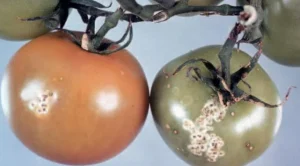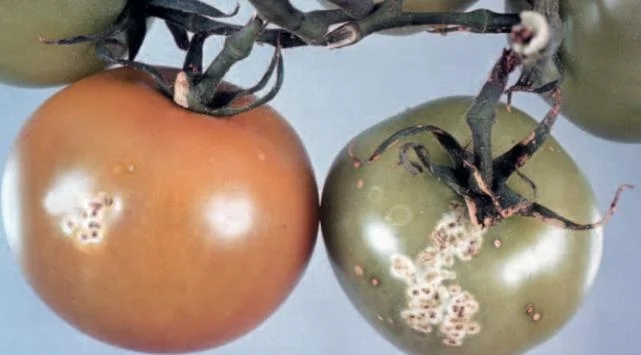
Clavibacter michiganensis subsp. michiganensis is the bacterium that causes bacterial wilt and canker on tomato. This tomato pathogen is designated as a regulated non-quarantine pest on tomatoes in the vegetable seed sector in the EU (https://rnqp.eppo.int/recommendations/).
Symptoms can be divided into two types, depending on whether infection is systemic (primary) within the vascular tissue or superficial (secondary) on plant surfaces (https://gd.eppo.int/taxon/CORBMI/photos). There is a greater risk of epidemic spread where superficial symptoms occur. Systemic infections cause blockage of the xylem vessels resulting in wilting, often on only one side of a leaf, which is initially reversible, with the leaves recovering in the cooler part of the day. Leaves may become stressed rather than wilted in more mature plants, and may develop windows of white and then brown interveinal necrotic tissue. Young petioles or leaves may show curved or distorted growth. Severe vascular infections result in removal of the epidermis and outer cortical tissue from the inner stem, if stems are squeezed between thumb and finger. The exposed tissues often have a soapy feel due to the copious production of fail to develop normally and fall or ripen unevenly, appearing marbled. Severely wilted plants often die. Superficial infections occur when bacteria multiply on the plant surface or within surface wounds and stomata. Leaves, stems and calyces may show a mealy appearance, as if dusted by coarse flour. Close examination reveals raised or sunken blisters which are usually white to pale orange. Mealy spots on stems are usually more discrete than those on leaves. A common leaf symptom is a dark brown spot surrounded by a yellow-orange area usually at the edge of the leaf. This results from infection of a water excreting gland. On fruits, superficial infections cause ‘bird’s eye’ spotting: raised, pale green or whitish pustules which develop a light brown centre and a chlorotic halo as the young fruit expands. Canker-like symptoms are actually rare; the disease’s most common name, bacterial canker, is in reality a misnomer. Source: https://horticulture.ahdb.org.uk/knowledge-library/bacterial-wilt-and-canker-of-tomato-clavibacter-michiganensis-subsp-michiganensis









